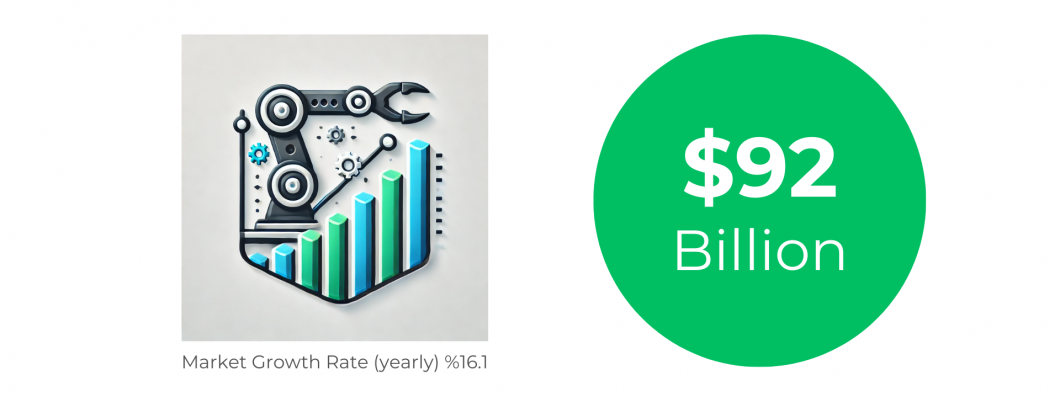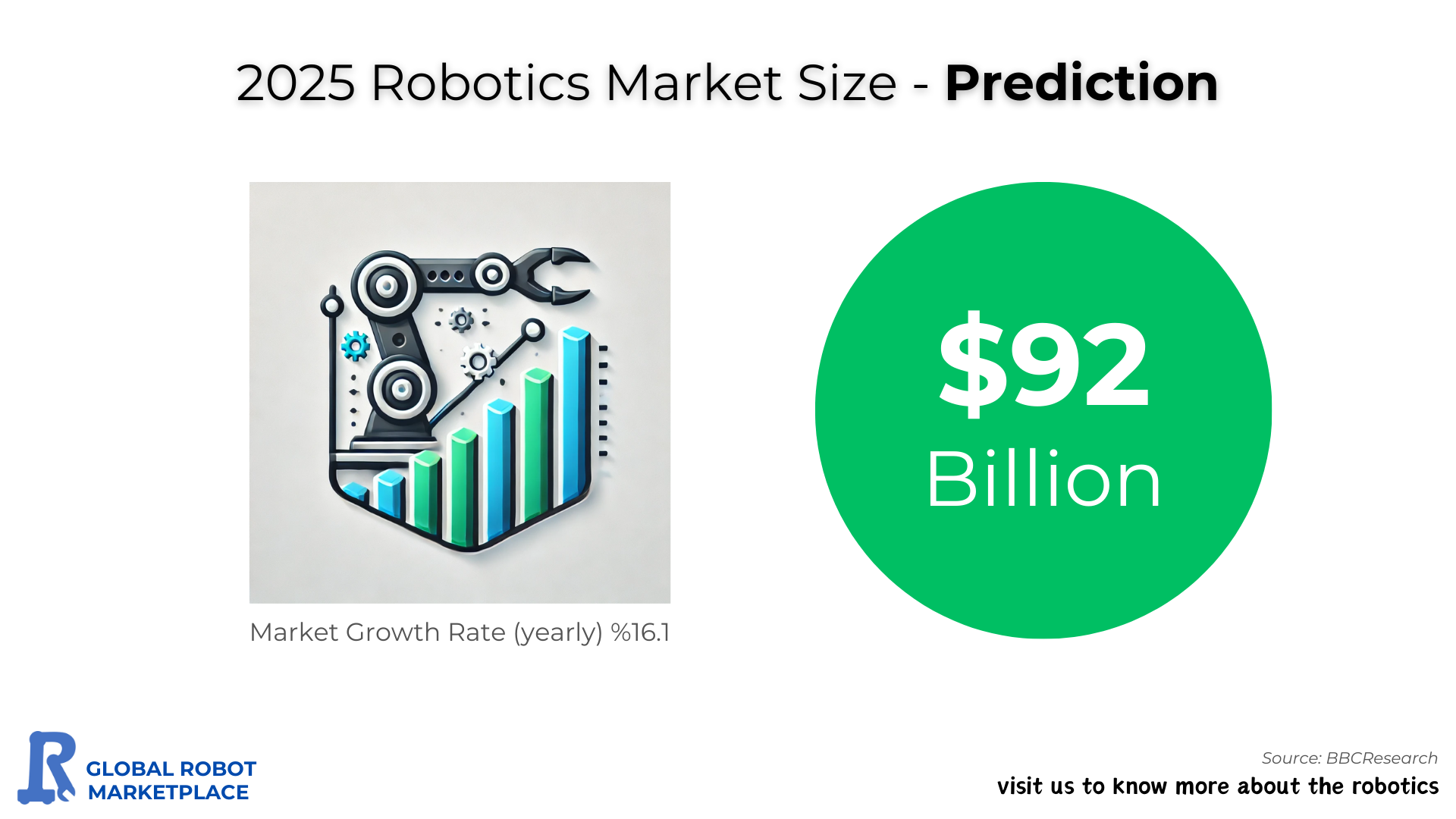
The robotics market is one of the most dynamic and rapidly expanding sectors in the global economy. According to recent research, the market is expected to reach a massive $92 billion by 2025, showcasing its potential to revolutionize industries and transform everyday life. The robotics market is experiencing remarkable growth, with a forecasted annual growth rate of 16.1%. This exponential rise is driven by several key factors, including technological advancements, the increasing demand for automation, and the growing recognition of the benefits robotics can bring to industries and consumers alike.

Understanding the Rise of Robotics
Robotics has evolved from a niche technology used primarily in industrial settings to a versatile and ubiquitous tool applicable across various sectors, including manufacturing, healthcare, logistics, and even entertainment. The future of robotics holds enormous potential, and its influence is likely to continue growing as innovation accelerates.
The projected growth rate of 16.1% annually indicates a rapidly maturing industry. This growth rate outpaces many other technology sectors, suggesting that robotics will play a pivotal role in shaping the global economy over the next several years. By 2025, robotics is poised to become a multi-billion-dollar industry, representing an incredible opportunity for businesses, investors, and innovators.
What Is Driving the Growth?
Several key factors contribute to the impressive growth of the robotics industry. These factors not only highlight the sector’s potential but also explain why robotics is being adopted across various industries at such a fast pace.
1. Technological Advancements
One of the primary drivers behind the growing robotics market is the continuous innovation in technology. In recent years, advancements in artificial intelligence (AI), machine learning, and robotics systems have made robots smarter, more efficient, and increasingly autonomous. These technologies have led to the development of robots that can perform a wider variety of tasks, from complex surgeries to intricate assembly line operations.
Improved sensors, computer vision, and enhanced processing power have made robots more capable than ever. This increased capability opens the door to numerous applications, including tasks that were once thought to be beyond the reach of automation. For example, autonomous vehicles, which rely on a combination of robotics, AI, and sensors, are making strides in transportation, further driving the demand for robotics solutions.
2. Automation in Manufacturing
Robots have long been a staple in manufacturing environments, where they help automate repetitive tasks such as assembly, welding, painting, and material handling. As global industries strive for greater efficiency and competitiveness, the demand for automation in manufacturing is increasing, driving the growth of robotics.
The adoption of industrial robots has already begun to improve productivity and reduce labor costs. As manufacturing processes become more complex and diverse, there is an increased need for robots that can perform tasks with greater precision, adaptability, and speed. Whether in automotive assembly lines, electronics manufacturing, or packaging, robots play an integral role in improving production lines' efficiency and output.
Furthermore, with the growing trend toward smart factories, where Internet of Things (IoT) devices, artificial intelligence, and robotics converge, manufacturers are creating fully automated, self-optimizing production systems. The rise of Industry 4.0 is expected to accelerate the need for advanced robotic systems, further boosting the robotics market's growth.
3. Healthcare Revolution
Healthcare is another sector that is increasingly relying on robotics to improve patient care and outcomes. Surgical robots, such as the da Vinci Surgical System, are already being used in hospitals worldwide to perform minimally invasive surgeries with unparalleled precision. These robots allow surgeons to make smaller incisions, reducing recovery times and minimizing the risks associated with traditional surgeries.
Moreover, robotics is also transforming the rehabilitation industry. Robotic exoskeletons and prosthetics are helping people with mobility impairments regain independence, while robotic-assisted physical therapy devices are enhancing patient recovery.
In addition, robots are used for routine tasks such as cleaning, disinfection, and medication delivery, improving hospital efficiency and reducing the risk of human error. As the aging population increases globally, the demand for healthcare robots is expected to rise significantly, further contributing to the robotics market’s growth.
4. Increased Investment in Robotics Innovation
Another key factor driving the robotics market’s rapid growth is the increasing investment in research and development (R&D). Governments, venture capitalists, and private companies are investing heavily in robotic technology, recognizing its potential to disrupt and revolutionize industries.
For instance, government-backed initiatives in countries like the United States, China, and the European Union are funding robotics research to stimulate innovation, create high-tech jobs, and improve their respective economies' global competitiveness. Additionally, private companies are pouring resources into developing new robotic solutions and technologies, including autonomous robots for agriculture, drones for delivery services, and robots for hazardous environment exploration.
These investments are fueling the development of more sophisticated, cost-effective robotic systems that will soon be accessible to businesses of all sizes, further boosting the adoption of robotics across various industries.
The Implications of a $92 Billion Market
As the robotics market heads towards a projected $92 billion valuation by 2025, its impact will be felt across every aspect of life. The increased availability and adoption of robotics will lead to the transformation of traditional industries, creating new business models and revolutionizing existing ones. This expansion will also have significant social and economic implications.
Job Creation and Skill Transformation
While robotics may reduce the need for certain manual labor jobs, it will also create new opportunities for workers skilled in robotics engineering, AI development, and systems integration. The shift toward a more automated world will require a highly skilled workforce, which may lead to the creation of thousands of new jobs in fields such as robotics design, programming, and maintenance.
Furthermore, industries that have already begun to implement robotics are experiencing a transformation in workforce dynamics, with human workers focusing on more complex, strategic, and creative tasks while robots handle repetitive, labor-intensive jobs.
Societal Benefits and Challenges
The widespread use of robotics will undoubtedly bring numerous societal benefits. For example, robots can help alleviate labor shortages in certain industries, such as healthcare, by performing tasks that would otherwise be too demanding for human workers. Additionally, robots can improve safety in hazardous environments, such as mining, construction, and firefighting, by taking on dangerous tasks.
However, the rapid rise of robotics also presents challenges. Ethical concerns related to automation, data privacy, and job displacement will need to be addressed as robots become more integrated into society. Policymakers, businesses, and researchers will need to work collaboratively to ensure that the benefits of robotics are maximized while minimizing any potential negative consequences.
The Future Is Robotic
With the robotics market expected to hit $92 billion by 2025, the industry is poised for a bright future. Innovations in AI, machine learning, and automation are set to continue reshaping industries, offering unprecedented opportunities for businesses and individuals alike. The next few years will be crucial for both the development and integration of robotics into our daily lives, and as technology advances, the possibilities are endless.
For businesses and individuals looking to capitalize on this growing trend, staying informed about the latest robotics developments is key. By exploring the potential of robotics now, businesses can position themselves at the forefront of the next technological revolution.
As we look toward 2025, one thing is clear: the future of robotics is not just on the horizon; it is already here.
